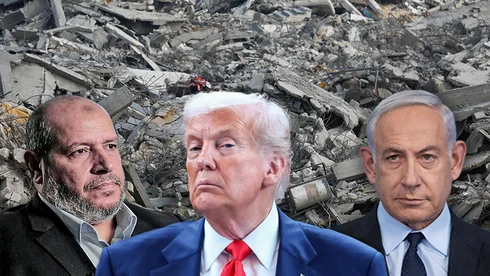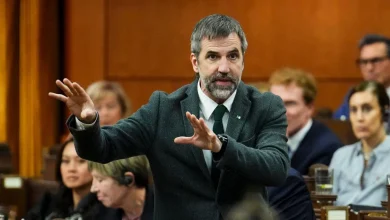Trump’s Gaza plan stalls as Western officials warn Hamas is regaining control

Western officials quoted by Reuters warn that the Gaza Strip is fracturing into two entities — one under Israeli control and the other under Hamas — as implementation of former U.S. President Donald Trump’s postwar plan remains stalled. The lack of progress, they said, could lead to “years of separation.”
According to the plan’s first phase, enacted October 10, Israel currently controls about 53% of Gaza’s territory, including large agricultural zones, Rafah in the south, and parts of Gaza City. Nearly all of Gaza’s 2 million residents have been forced into tent camps and the ruins of shattered neighborhoods still under Hamas control.
4 View gallery
Khalil al-Hayya, Donald Trump, Benjamin Netanyahu
(Photo: Reuters/Evelyn Hockstein, AP/Jehad Alshrafi, Alex Kolomoisky, Reuters/Mahmoud Issa)
Amid the political deadlock, Washington is reportedly pressing Israel to allow “safe passage” for about 200 Hamas terrorists trapped in tunnels beneath Rafah on the Israeli-controlled side of the so-called yellow line. Under one idea, the terrorists would surrender and hand over their weapons in exchange for amnesty or exile, while the tunnels would be destroyed.
The pressure has intensified during a visit to Israel by Jared Kushner, Trump’s son-in-law and one of the architects of the Gaza plan. An Israeli official told Ynet that “given the pressure, it’s hard to believe we’ll eliminate them. There’s heavy U.S. involvement, and it will likely be resolved through a negotiated deal.”
Washington believes that after the return and burial of Lt. Hadar Goldin’s remains—4,118 days after his 2014 abduction—Prime Minister Benjamin Netanyahu may now have greater political latitude to advance the plan. However, Netanyahu’s office said he “did not commit to the Americans to release the Rafah terrorists.”
The next stage of the Trump plan envisions a further IDF withdrawal beyond the yellow line, creation of a transitional governing authority, deployment of a multinational force to replace Israeli troops, Hamas’s disarmament, and the start of reconstruction. But no timelines or enforcement mechanisms have been agreed upon. Hamas refuses to disarm, Israel opposes any Palestinian Authority involvement, and uncertainty persists over the multinational force.
4 View gallery
IDF forces in the yellow line
(Photo: IDF)
“We’re still working out ideas,” Jordanian Foreign Minister Ayman Safadi said this month at a security conference in Manama. “Everybody wants this conflict over, all of us want the same endgame here. Question is, how do we make it work?”
Without a major U.S. push to break the impasse, the yellow line could become the de facto border dividing Gaza indefinitely, according to 18 sources—including six European officials and a former U.S. official familiar with the talks.
The U.S. has drafted a UN Security Council resolution that would grant the transitional authority and multinational force a two-year mandate, but 10 diplomats told Reuters that governments remain reluctant to commit troops. European and Arab nations in particular were unlikely to participate if the mission extended beyond peacekeeping and required direct confrontation with Hamas.
U.S. Vice President J.D. Vance and Kushner have proposed sending reconstruction funds first to Israeli-controlled areas, creating “model zones” for some Gazans to live in. But analysts at the International Crisis Group warned the idea could “lock in a fragmented reality” and entrench division for the long term.
4 View gallery
Jared Kushner meets with Netanyahu
(Photo: Haim Zach/GPO)
A U.S. State Department spokesperson said “tremendous progress” had been made in advancing the plan but acknowledged “more work” was needed, without saying whether rebuilding would be limited to the Israeli-controlled side.
Netanyahu has insisted Israel has no intention of re-occupying or governing Gaza, though some far-right ministers have called for reviving the settlements dismantled in 2005. The IDF likewise opposes direct rule, preferring to maintain a buffer zone inside Gaza to prevent future attacks like that of October 7.
Israeli forces have placed large yellow concrete blocks along the withdrawal line and are building infrastructure on the side they control. In Gaza City’s Shejaiya neighborhood, journalists were shown fortified Israeli outposts established after the cease-fire. Satellite images show earth and debris bulldozed into steep mounds forming elevated vantage points.
4 View gallery
Gaza
(Photo: Reuters/Mahmoud Issa)
IDF spokesperson Lt. Col. Nadav Shoshani said the soldiers were there to prevent terrorists from crossing into the Israel-controlled zone and that Israel would move further once Hamas meets its obligations. “As soon as Hamas holds their part of the agreement we are ready to move forward,” he said.
An Israeli government official told Reuters that Israel was adhering to the plan and accused Hamas of stalling. So far, Hamas has released the final 20 living hostages and the remains of 24 others but still holds four bodies.
Across Gaza City, Hamas has reasserted itself in recent weeks—executing rivals, policing neighborhoods, and assigning civil workers to clear rubble and guard food stalls, Reuters footage showed.
“We really need to fill the vacuum within the Gaza Strip for security,” German Foreign Minister Johann Wadephul said at the Manama conference. “A Hamas resurgence could trigger renewed Israeli military operations in Gaza.”
Hamas spokesperson Hazem Qassem said the group was prepared to hand over administration to a Palestinian technocratic authority to enable reconstruction. “All the regions of Gaza deserve reconstruction equally,” he said.
Western and Arab officials are now weighing whether Hamas could decommission its weapons under international supervision instead of surrendering them directly to Israel. Arab and European states insist the Palestinian Authority return to govern Gaza alongside the multinational force—a proposal Israel rejects.
European officials warned that without changes in Hamas’s or Israel’s stance—or U.S. pressure on Israel to accept Palestinian involvement—the Trump plan will not advance beyond the cease-fire. “Gaza must not get stuck in a no man’s land between peace and war,” British Foreign Secretary Yvette Cooper said.
Gaza City resident Salah Abu Amr, 62, told Reuters that if rebuilding begins only in the Israeli-controlled area, many would try to relocate there. “Are we all going to be able to move into that area? Or Israel will have a veto over the entry of some of us,” he said. “Are they also going to divide the families between good people, bad people?”
Gulf states have refused to finance reconstruction without Palestinian Authority participation or a path to statehood. The rebuilding cost is estimated at $70 billion. Diplomats warned that a de facto split of Gaza would worsen the humanitarian catastrophe and deepen dependence on foreign aid.
“We cannot have a fragmentation of Gaza,” Jordan’s Safadi said. “Gaza is one, and Gaza is part of the occupied Palestinian territory.”
Palestinian Foreign Minister Varsen Aghabekian Shahin added, “There can be no genuine reconstruction or lasting stability without full Palestinian sovereignty over the territory.”





